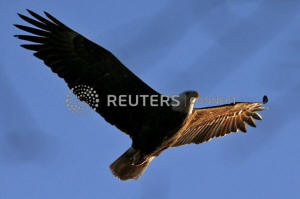|
Free birds: Bald eagles stir U.S.
patriotism as web-cam stars
 Send a link to a friend
Send a link to a friend
 [July 03, 2019]
By Barbara Goldberg [July 03, 2019]
By Barbara Goldberg
(Reuters) - On the brink of extinction a
half-century ago, the bald eagle is thriving in the internet age,
fascinating a devoted corps of Americans who regularly monitor the
majestic birds of prey via web-cams set up at more than a dozen nests in
the wild.
The bald eagle, designated as the national emblem of the United States
in 1782, has long symbolized the American ideal of freedom. For people
like Kevin Fossett, a U.S. Navy veteran who likes to check up on a nest
in Florida, the sight of the birds stirs feelings of patriotism,
especially with the approach of Independence Day.
Fossett said in recent years he has watched several eagle eggs as chicks
inside peck through the shells and emerge as newborns, usually in the
winter or early spring. By July 4, the eaglets typically have taken
flight and left the nest.
"Flying free, as they should be," said Fossett, 50. "Total independence,
just like our national holiday."
Fossett clicks on an "eagle-cam" daily using a tablet on his screen
porch in St. Petersburg, Florida, or at his fishing equipment business.
He watches a nest more than 220 miles (354 km) away, near Jacksonville.

At least 15 cameras focused on bald eagle nests around the United States
are streaming live images 24 hours a day, seven days a week, said
Shawnlei Breeding, EagleWatch Program manager at the Audubon Center for
Birds of Prey.
"Bald eagles inspire a lot of passion in their fans," Breeding said.
"They become like family to the people who watch them."
The birds typically mate for life and use the same nest year after year
to raise their young.
An eagle-cam in Decorah, Iowa, went viral in 2011 with 280 million
views, and the site has drawn in many more over the years, said Amy Ries,
spokeswoman for Raptor Resource Project, a non-profit organization that
runs it. Seven eagle-cams at Explore.org saw a 223% increase in views in
2018 compared with 2017.
High-definition images streamed from the roosts allow the eagle fans to
see close-ups of the birds. Viewers are able to count feathers, observe
iris patterns or identify the bird's prey before it is consumed.

"We can see the tiny eyelashes of an eagle," said Veronika Soul, 74, a
retired filmmaker who lives in New York's Harlem neighborhood and
watches two Decorah bald eagle nests daily. "We see things happen at
nest level that people on the ground never see."
[to top of second column]
|

The last rays of sunlight illuminate an American Bald Eagle as it
soars above the Hudson River just before sunset near Croton Point in
Croton-on-Hudson, New York, March 23, 2015. REUTERS/Mike Segar/File
Photo

The technology allows cameras to be rotated remotely, providing
glimpses of life beyond the nest. Viewers say it is especially fun
to see fledglings take their first flights.
Viewers of the Iowa nest recently saw an eaglet who was accidentally
knocked off the nest. It managed to jump and flutter high enough up
the branches of an adjacent tree to drop back into its family's
nest.
Pesticide poisoning and human encroachment on their habitat
threatened eagles with extinction, with only an estimated 487 pairs
remaining by 1963, according to the federal wildlife website.
After decades of federal protection, the eagle started a comeback.
The turning point came in 1972 when the Environmental Protection
Agency banned the pesticide DDT. The population has soared since
then, and in 2007 the bald eagle was removed from the endangered
list.
Ten years ago, there were 143,000 bald eagles in the United States,
according to a 2009 U.S. Fish and Wildlife Service (FWS)survey, the
most recent data available. Updated numbers are expected to be
released next year and preliminary data indicate the population is
rising, said FWS spokeswoman Vanessa Kauffman.
Most bald eagles are found in Alaska, while Minnesota, Wisconsin and
Florida also have large populations, according to Breeding.

Worldwide, the bald eagle population is 250,000, with 88% spending
part of the year in the United States, 31% in Canada and 8% in
Mexico, said Patricia Leonard, spokeswoman for Cornell Lab of
Ornithology in Ithaca, New York.
Eagle-watching can be a source of patriotic pride or a therapeutic
way to ease the pain of illness, loss and even dying, avian experts
say.
"In an eagle's nest, life goes on," Ries said. "When we look into
the nest, we see something of ourselves staring back at us, but we
also see something wild beyond our comprehension."
(Reporting by Barbara Goldberg in New York; editing by Frank McGurty
and Sandra Maler)
[© 2019 Thomson Reuters. All rights
reserved.]
Copyright 2019 Reuters. All rights reserved. This material may not be published,
broadcast, rewritten or redistributed.
Thompson Reuters is solely responsible for this content. |